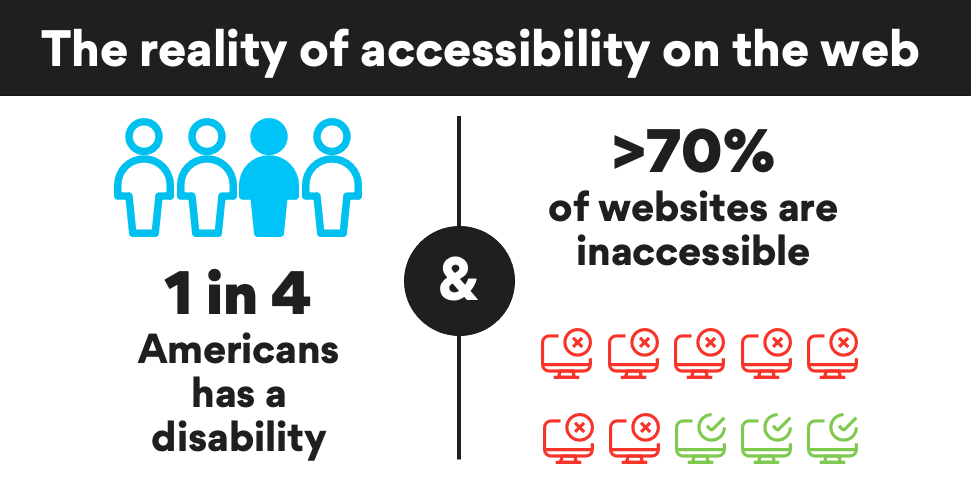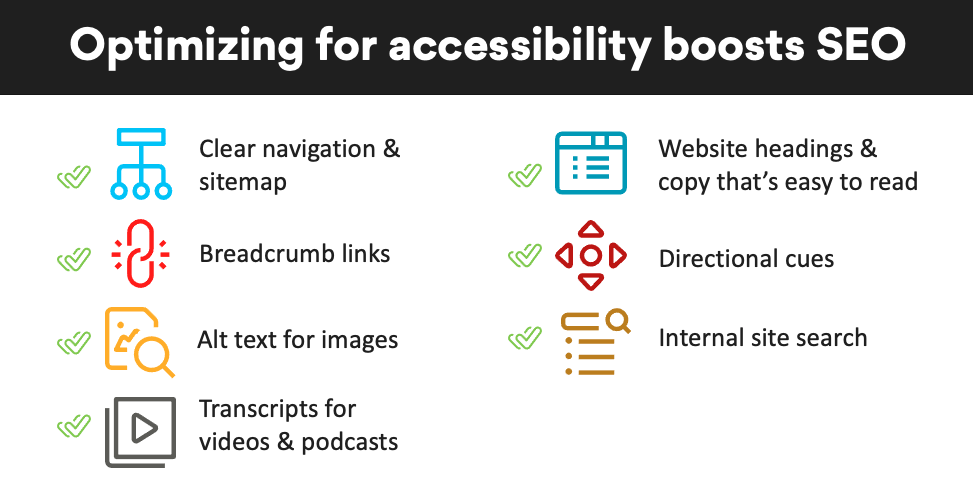Innovative organizations recognize that meeting the needs of diverse populations is key to the growth of their business. However, an often underrecognized group is people with disabilities. Manufacturing organizations must begin to consider the unique needs of this underserved audience.
Digital accessibility cannot be an afterthought or a “someday initiative” for these titans of industry. Creating inclusive experiences, technologies, and pathways for individuals with disabilities is the right thing to do and, in turn, helps everyone—from underserved audiences to the business itself.
Why is digital accessibility important?
Accessibility is all about inclusion and as our daily lives become more and more digital, the number of people accessing the internet increases exponentially.
In February 2020, Web Aim used its WAVE accessibility engine to analyze one million home pages, assessing accessibility barriers and web content accessibility guidelines (WCAG) failures. This study found that 98% of homepages had detectable WCAG failures.
Unfortunately, this indicates a majority of websites today cannot be accessed by people with certain disabilities.
There are five key areas in which manufacturers and ecommerce businesses should consider digital accessibility:
- Disability and the world wide web
- A gateway to inclusion
- Protect your business from lawsuits
- Market opportunity
- Boost your SEO efforts
1. Disability and the world wide web
According to the CDC, one in four people in the United States lives with a disability. Within that staggering statistic, approximately 15 million Americans live with a visual disability. As you can imagine, this is a huge hurdle in access to the web, as it’s a largely visual medium.

Websites and apps can be built to be easily read by assistive technology such as screen readers, screen magnifiers, etc. Many disabled people rely on these technologies to perform everyday tasks. Additionally, websites can be designed to accommodate conditions such as colorblindness, dyslexia, dyscalculia, seizures, and migraine triggers.
Website structure and content can also be developed to proactively address issues related to reading comprehension level.
2. A gateway to inclusion
Many businesses committed to creating a diverse and inclusive work environment for their employees—but these accommodations have been largely physical. Manufacturers should also consider their digital platforms, such as software systems, time tracking, ordering, project management, and email programs. Are these tailored to disabled audiences?
Often, accessibility is considered upfront and addressed after the fact. You may want to deliver an MVP website now and “make it accessible” as a phase two deliverable. This generally incurs a great expense to the business because it can require a complete restructure of your website.
Manufacturers who want to be truly inclusive must create accessible digital experiences from the get-go—identifying needs and potential barriers of audiences with disabilities early in the process. Then, you should test the site with members of this audience to ensure it meets their needs.
3. Protect your business from lawsuits
Thirty years ago, there was a push for inclusion of disabled people in all aspects of public and private life—an ideal that had been far from reality for some time. Thus, The Americans with Disabilities Act (ADA) was signed, bringing the needs of people with disabilities to the forefront.
Over the years, progress has been made to ensure businesses, homes, public accommodations, etc., have been built with inclusion in mind. However, its estimated that more than 70% of websites are not accessible.
Imagine shopping for something online and being unable to click the “buy” button or identify the price. Or getting through the checkout process only to learn that the “submit order” button is not actually clickable. Or trying to order something that’s only described in text placed in photos that you can’t see. Imagine the frustration of being unable to identify critical product attributes for something that you want—or need— to purchase for your business.
This is exactly what many people living with a disability experience, both on the consumer level and in B2B purchases.
This is a significant concern for businesses, as it leaves your organization liable in an ADA lawsuit. And lawyers don’t discriminate. In early 2019, even Beyonce was hit with an accessibility lawsuit from a woman who had no vision claiming the website was not fully accessible for her and millions of others.
So, not only are accessible websites the right thing to do—they can save your company time, money, and litigation.
4. Open a new market of opportunity
According to W3C, accessibility “means that websites, tools, and technologies are designed and developed so that people with disabilities can use them. More specifically, people can: perceive, understand, navigate, interact with the web, and contribute to the web.”
Making your ecommerce site accessible for people with disabilities is a smart business move because you’re enabling more customers to buy from your website. What’s more, recent research has uncovered that there are billions of dollars in potential revenue if accessibility needs are accommodated.
Frequently, prospective customers land on a website with a task to accomplish, like ordering replacement parts for a warehouse forklift. The more barriers to purchase, such as complex navigation and unfamiliar nomenclature, the more opportunities you give the buyer to bounce (figuratively and literally).
Investing in the creation of accessible and inclusive experience should ultimately result in positive ROI for your business.
5. Boost your SEO efforts
In many cases, good accessibility practices also improve your site’s search engine optimization and user experience for all people, not only those with disabilities.
McKinsey & Company found that the COVID-19 pandemic speeded the adoption of digital technologies by several years—and many of these changes could be here for the long haul. This digitization of the customer and supply chain was necessary to stay competitive which means a majority of customers have moved dramatically toward online channels.
To ensure your customers are finding what they need on your website, it is key to have a focused, user-optimized experience.
So, how does this relate to accessibility? People with disabilities also need websites that are simple and easy to navigate.
This demand for accessible sites presents another opportunity for B2B ecommerce businesses; accessibility practices and SEO tactics often overlap.
Examples that give you double the bang for your buck here include:
- Clear navigation and sitemap
- Breadcrumb links
- Alt text for images
- Transcripts for videos and podcasts
- Website headings and copy that’s clear, conversational, and easy to read
- Directional cues (crosslinking, navigation through the site)
- Internal site search

When you make your website more accessible, you’re also likely to see Google prioritize your website on search result pages—maybe even more than your competitors who aren’t doing the same.
How to translate this to your website
Now that you’ve seen the impacts of accessible design, how do you apply it?
Universal elements
When building a new website, you should consider incorporating inclusive design principles. This approach puts people first—designing for the needs of all people. These principles include:
- Provide comparable experience – All people can accomplish tasks in a way that suits their needs.
- Consider situation – People use your interface in different situations. Make sure your interface delivers a valuable experience.
- Be consistent – Use familiar conventions and apply them consistently.
- Give control – Allow people to access and interact with content in their preferred way.
- Offer choice – Provide different ways for people to complete tasks, especially complex ones.
- Prioritize content – Help users focus on core tasks, features, and information by prioritizing them within the content and layout.
- Add value – Ensure the value of the features you’re providing on the website contributes to improving the experience for different users.
Lastly, and arguably the most important element, is the navigation. Developing an intuitive sitemap, understandable nomenclature, effective labeling, and repeatable page patterns is incredibly important for accessibility.
When this infrastructure is produced, it shouldn’t matter if you’re navigating with a mouse, keyboard, or screen reader. Users should be able to explore the site easily and effectively.
Page design
A common issue is that web pages are designed beautifully but many of the design elements are inaccessible. Core issues include color contrast, simple design, and font type.
To ensure your color choices have the appropriate level of contrast, check a web accessibility contrast checker. Depending on the level of accessibility you’re building for, your contrast level will vary.
As a manufacturing brand, you cannot not rely primarily on color to make your design work. Some users can’t decern color, so that design strategy effectively limits their interaction with your website.
When it comes to font type, stick with a sanserif 16px font or larger to ensure legibility.
Alt text
By adding alt text, screen readers and other assistive technology can read image descriptions, which helps them better understand the content of the page. And if an image doesn’t load on the page, the alt-text will display instead—meaning no blank images on your website.
As another added SEO bonus, alt text also provides better context for search engine crawlers to index the image properly. Because Google isn’t human, it can’t “see” images on a website. You don’t want to leave search engine interpretation to chance. Whenever possible, in the description of the images, include keywords you’d like to rank for. But don’t force it. Alt text must make sense to both search bots and visually impaired individuals.
You can find some detailed examples of alt text in this blog article on our site.
Testing
According to a recent survey by Forbes, more than half of organizations still don’t routinely test their digital products with disabled audiences to evaluate their accessibility and usability. This is a critical step to improve your site’s performance and reduce risk that you’ll fail to meet their needs.
At Ntara, we work in collaboration with the nation’s second largest employer of blind and visually impaired people, the Envision BVI Workforce Innovation Center, to ensure our websites follow the latest industry accessibility guidelines.
A wide range of accessibility testing tools are available to review and monitor the accessibility of your website. When making website updates or optimizations, pressure check any new designs and systems as part of your quality control routine.
Additional references for accessibility standards
- Quick reference to Web Content Accessibility Guidelines (WCAG)
- Layman’s version of WCAG 2.1 for testers, designers, and developers
- WCAG standards and legislation
- Americans with Disabilities Act (ADA)
- Section 508
- Website accessibility and the law
- W3C WAI policies